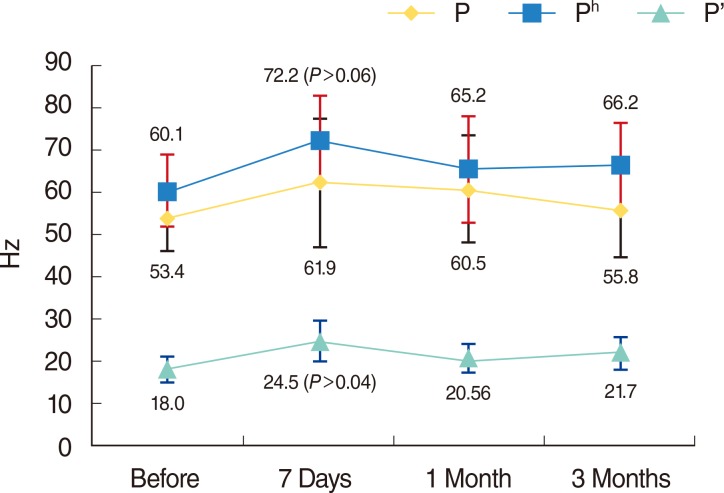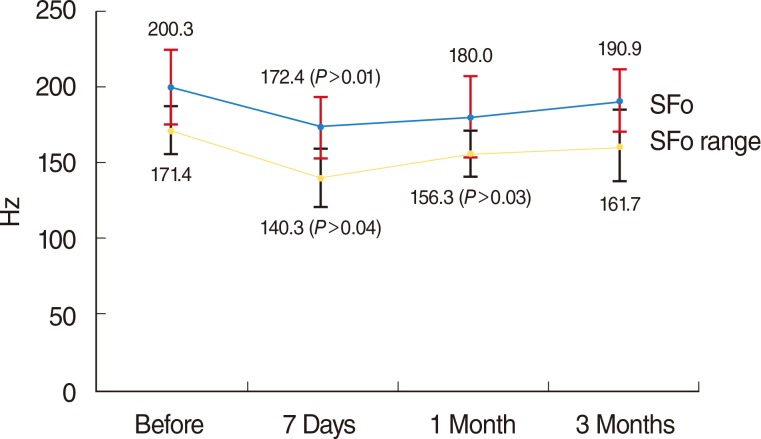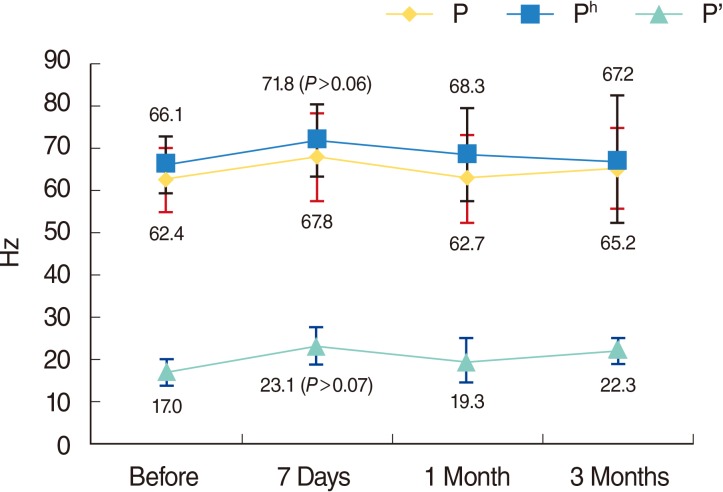Clin Exp Otorhinolaryngol.
2015 Jun;8(2):155-160. 10.3342/ceo.2015.8.2.155.
The Effect of Total Thyroidectomy on the Speech Production
- Affiliations
-
- 1Department of Otolaryngology-Head and Neck Surgery, Research Institute of Clinical Medicine, Chonbuk National University Medical School, Jeonju, Korea. khhong@chonbuk.ac.kr
- KMID: 2360787
- DOI: http://doi.org/10.3342/ceo.2015.8.2.155
Abstract
OBJECTIVES
Voice and speech alternations that can occur after total thyroidectomy are usually due to recurrent or superior laryngeal nerve injury. These alterations may also be associated with other extralaryngeal factors, such as neck muscle dysfunction and scar contracture of the neck. We performed a prospective acoustic analysis on speech changes after surgery, in the absence of laryngeal nerve injury.
METHODS
Patients aged 19 to 58 years undergoing total thyroidectomy, in the absence of laryngeal/pulmonary disease, previous neck surgery, or other malignant diseases, were recruited prospectively. For the running speech analysis, the speaking fundamental frequencies (SFo), range of SFo and speaking intensity were evaluated before surgery, 7 days, and 1 and 3 months after surgery. For consonant analysis, the acoustic distinctions of stop consonant, the voice onset time (VOT), vowel duration and closure duration were evaluated at the same periods.
RESULTS
SFo and range of SFo were specifically diminished after surgery, while speaking intensities were not changed significantly after surgery. The thyroidectomized speakers displayed systematically varied VOT for the consonant production, which was phonetically representative. However, VOT after surgery could be longer in the strong aspirated and glottalized stops, but not in the lax stop than before surgery. The vowel and closure durations were not affected before and after surgery.
CONCLUSION
Patients with thyroidectomy have some difficulty of pitch control and consonant articulation during speaking. VOT is also one of the meaningful acoustic parameters and provide a reference for comparing acoustic measures before and after thyroidectomy.
Keyword
MeSH Terms
Figure
Cited by 2 articles
-
Cepstral Analysis of Voice in Patients With Thyroidectomy
Yu Jeong Shin, Ki Hwan Hong
Clin Exp Otorhinolaryngol. 2016;9(2):157-162. doi: 10.21053/ceo.2015.00199.Changes in Oral Vowel Sounds and Hyoid Bone Movement After Thyroidectomy
Ki Hwan Hong, Woo Seok Yang, Min Ju Park, Jong Seok Oh, Baek Hwa Han
Clin Exp Otorhinolaryngol. 2017;10(2):168-173. doi: 10.21053/ceo.2015.01585.
Reference
-
1. HUNT CJ. The superior and inferior laryngeal nerve as related to thvroid surgery. Am Surg. 1961; 7. 27:548–552. PMID: 13716843.2. Stojadinovic A, Shaha AR, Orlikoff RF, Nissan A, Kornak MF, Singh B, et al. Prospective functional voice assessment in patients undergoing thyroid surgery. Ann Surg. 2002; 12. 236(6):823–832. PMID: 12454521.
Article3. Sinagra DL, Montesinos MR, Tacchi VA, Moreno JC, Falco JE, Mezzadri NA, et al. Voice changes after thyroidectomy without recurrent laryngeal nerve injury. J Am Coll Surg. 2004; 10. 199(4):556–560. PMID: 15454138.
Article4. Debruyne F, Ostyn F, Delaere P, Wellens W. Acoustic analysis of the speaking voice after thyroidectomy. J Voice. 1997; 12. 11(4):479–482. PMID: 9422284.
Article5. Hong KH, Kim YK. Phonatory characteristics of patients undergoing thyroidectomy without laryngeal nerve injury. Otolaryngol Head Neck Surg. 1997; 10. 117(4):399–404. PMID: 9339803.
Article6. McIvor NP, Flint DJ, Gillibrand J, Morton RP. Thyroid surgery and voice-related outcomes. Aust N Z J Surg. 2000; 3. 70(3):179–183. PMID: 10765899.
Article7. Sonninen A. The external frame function in the control of pitch in the human voice. Ann N Y Acad Sci. 1968; 11. 155(1):68–90.
Article8. Hong KH, Ye M, Kim YM, Kevorkian KF, Berke GS. The role of strap muscles in phonation--in vivo canine laryngeal model. J Voice. 1997; 3. 11(1):23–32. PMID: 9075173.9. Lisker L, Abramson AS. Some effects of context on voice onset time in English stops. Lang Speech. 1967; Jan-Mar. 10(1):1–28. PMID: 6044530.
Article10. Kagaya R. A fiberscopic and acoustic study of the Korean stops, affricates and fricatives. J Phon. 1974; 2:161–180.
Article11. Hirose H, Lee CY, Ushijima T. Laryngeal control in Korean stop production. J Phon. 1974; 2:145–152.
Article12. Hong K, Niimi S, Hirose H. Laryngeal adjustments for the Korean stops, affricates and fricatives: an electromyographic study. Annu Bull Res Inst Logop Phoniatr. 1991; (25):17–31.13. Martensson H, Terins J. Recurrent laryngeal nerve palsy in thyroid gland surgery related to operations and nerves at risk. Arch Surg. 1985; 4. 120(4):475–477. PMID: 3985793.
Article14. Dursun G, Sataloff RT, Spiegel JR, Mandel S, Heuer RJ, Rosen DC. Superior laryngeal nerve paresis and paralysis. J Voice. 1996; 6. 10(2):206–211. PMID: 8734396.
Article15. Hirano M, Koike Y, von Leden H. The sternohyoid muscle during phonation: electromyographic studies. Acta Otolaryngol. 1967; Nov-Dec. 64(5):500–507. PMID: 6083377.
Article16. Simada Z, Hirose H. The function of the laryngeal muscles in respect to the word accent distinction. Annu Bull Res Inst Logop Phoniatr. 1970; (4):27–40.17. Keilmann A, Hulse M. Dysphonia following strumectomy with normal respiratory movement of the vocal cords. Folia Phoniatr (Basel). 1992; 44(6):261–268. PMID: 1286838.18. Kori S, Sugito M, Hirose H, Niimi S. Participation of the sternohyoid muscle in pitch lowering: evidence from Osaka Japanese. Annu Bull Res Inst Logop Phoniatr. 1990; (24):65–75.19. Hollien H, Jackson B. Normative data on the speaking fundamental frequency characteristics of young adult males. J Phon. 1973; 1:117–120.
Article20. Robinson JL, Mandel S, Sataloff RT. Objective voice measures in non-singing patients with unilateral superior laryngeal nerve paresis. J Voice. 2005; 12. 19(4):665–667. PMID: 16129578.
Article21. Kark AE, Kissin MW, Auerbach R, Meikle M. Voice changes after thyroidectomy: role of the external laryngeal nerve. Br Med J (Clin Res Ed). 1984; 11. 289(6456):1412–1415.
Article
- Full Text Links
- Actions
-
Cited
- CITED
-
- Close
- Share
- Similar articles
-
- A Case of Voice Therapy for Patient Who Voice Changed after Total Thyroidectomy Using Contactless Voice and Speech Therapy Service Platform
- Comparison of Speech Rate and Long-Term Average Speech Spectrum between Korean Clear Speech and Conversational Speech
- Acoustic characteristics of patients undergoing short-term endotracheal intubation with or without thyroidectomy who had no nerve injury
- A Study of Korean Literature Review Related to Speech Characteristics and Speech Therapy in Patients with Parkinson Disease
- Respiration Patterns and Abdominal Muscle Activities during Speech Production in Athetoid Cerebral-Palsied Patients





